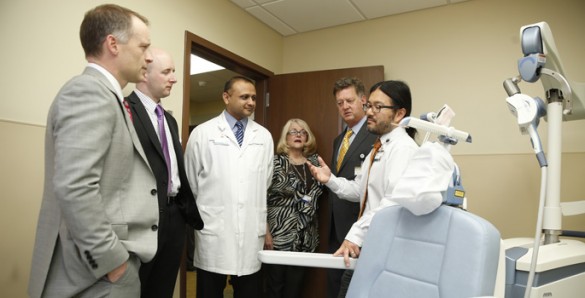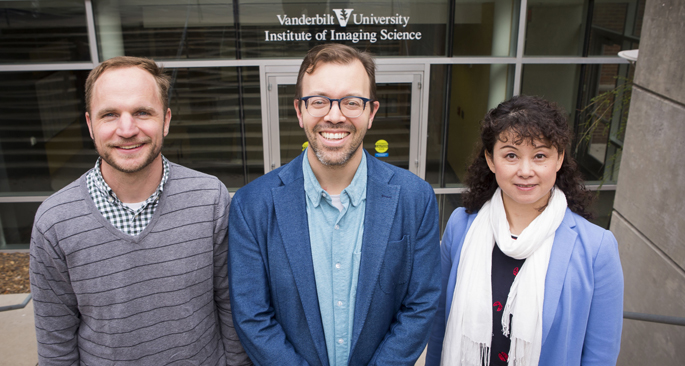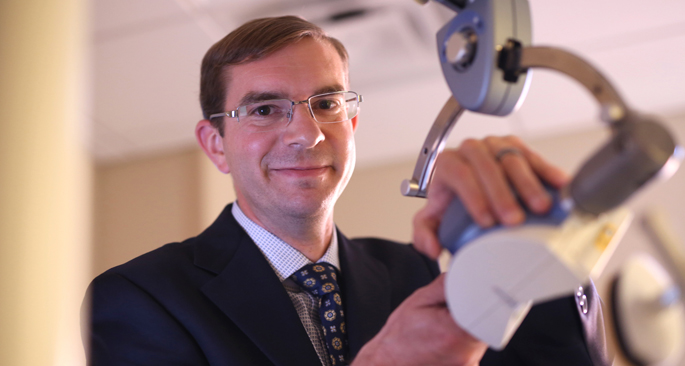
Vanderbilt Behavioral Health (VBH) opened a neuromodulation suite this week for two brain stimulation procedures that can offer relief to patients diagnosed with disabling psychiatric conditions when psychotherapy and medications don’t work or aren’t advised.
The neuromodulation suite, housed on the first floor of Vanderbilt Psychiatric Hospital (VPH), is the hospital’s first procedural unit and has six bays that can be used for electroconvulsive therapy (ECT) and a room dedicated to transcranial magnetic stimulation (TMS).
With ECT electric currents are passed through the brain, intentionally triggering a brief seizure. It appears to cause changes in brain chemistry that can quickly improve symptoms of certain mental illnesses, like major depressive disorder, bipolar disorder and some types of schizophrenia.
Formerly known as shock therapy, ECT was stigmatized in its earlier years, partially because of depictions on TV and in the movies. Now administered with anesthesia and medications to relax the muscles, it is a much safer treatment option today.
“Developed in the 1930s when there were no other medical options, it was the dominant treatment for decades, and then went somewhat out of favor,” said Nathaniel Clark, M.D., associate professor of Clinical Psychiatry and clinical director of the Psychiatric Adult Inpatient Service. “There’s been a resurgence in ECT over the past 10 years.”
Transcranial magnetic stimulation (TMS) is a non-invasive procedure used to improve symptoms of depression. Electrical pulses are sent by a device held to the forehead to the prefrontal cortex, the region of the brain linked to mood. The patient is not sedated and sits in a chair similar to a dentist’s chair.
Clark said that it is not known exactly how ECT and TMS work, only that they both stimulate the region of the brain involved in mood control.
The new suite is both aesthetically appealing and easy to navigate for the patients and their families.
“For the past seven years, since we began offering ECT, our patients have been transported from the Psychiatric Hospital across the street to the PACU (Post Anesthesia Care Unit) in the main hospital’s OR for the procedures,” said Harsh Trivedi, M.D., vice chair for Clinical Affairs in the Department of Psychiatry and executive director and chief medical officer of Vanderbilt Behavioral Health.
“If you can imagine being depressed or psychotic to the point you need ECT, the idea of being in our OR space with all the other things going on is overwhelming. And we could only transport a few patients, the sickest, those at most risk to be harmful to themselves or others,” he said.
“Now our patients never have to leave the building. They go from one safe area into another, where we can control the environment much better. This is about providing meaningful, thoughtful, patient-centered care.”
Trivedi said the new suite will also allow more patients to receive the therapy, since the suite is dedicated solely to ECT and TMS procedures. Until now ECT and TMS could only be done three days a week; now the suite will be operational Monday-Friday.
“This means we can actually increase volume to better meet the demand that exists.”
It often takes between six and 12 ECT sessions for patients to see a dramatic improvement in their depression or psychosis, Trivedi said.
And some patients require maintenance therapy once a month or every six weeks so that it remains an effective treatment.
For those patients, the suite’s separate entrance will be beneficial.
“Our patients will be able to be driven right up to the building and have a 20-foot walk into the entrance. It’s a beautifully decorated suite. There’s a waiting room for patients and families. They will be where they know people, and where they feel comfortable. It’s a much better patient experience,” Trivedi said.















